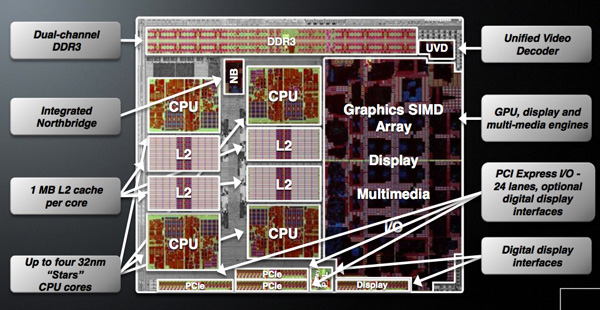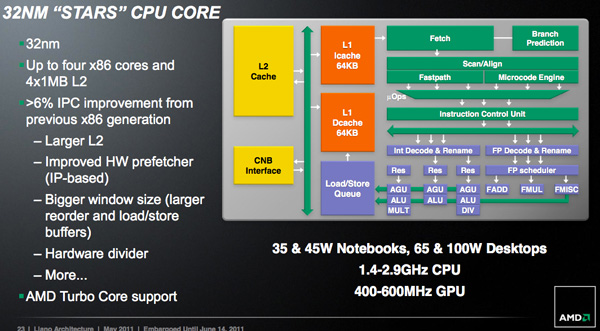The AMD Llano Notebook Review: Competing in the Mobile Market
by Jarred Walton & Anand Lal Shimpi on June 14, 2011 12:01 AM ESTThe Llano A-Series APU
Although Llano is targeted solely at the mainstream, it is home to a number of firsts for AMD. This is AMD's first chip built on a 32nm SOI process at GlobalFoundries, it is AMD's first microprocessor to feature more than a billion transistors, and as you'll soon see it's the first platform with integrated graphics that's actually worth a damn.
AMD is building two distinct versions of Llano, although only one will be available at launch. There's the quad-core, or big Llano, with four 32nm CPU cores and a 400 core GPU. This chip weighs in at 1.45 billion transistors, nearly 50% more than Sandy Bridge. Around half of the chip is dedicated to the GPU however, so those are tightly packed transistors resulting in a die size that's only 5% larger than Sandy Bridge.
| CPU Specification Comparison | ||||||||
| CPU | Manufacturing Process | Cores | Transistor Count | Die Size | ||||
| AMD Llano 4C | 32nm | 4 | 1.45B | 228mm2 | ||||
| AMD Llano 2C | 32nm | 2 | 758M | ? | ||||
| AMD Thuban 6C | 45nm | 6 | 904M | 346mm2 | ||||
| AMD Deneb 4C | 45nm | 4 | 758M | 258mm2 | ||||
| Intel Gulftown 6C | 32nm | 6 | 1.17B | 240mm2 | ||||
| Intel Nehalem/Bloomfield 4C | 45nm | 4 | 731M | 263mm2 | ||||
| Intel Sandy Bridge 4C | 32nm | 4 | 995M | 216mm2 | ||||
| Intel Lynnfield 4C | 45nm | 4 | 774M | 296mm2 | ||||
| Intel Clarkdale 2C | 32nm | 2 | 384M | 81mm2 | ||||
| Intel Sandy Bridge 2C (GT1) | 32nm | 2 | 504M | 131mm2 | ||||
| Intel Sandy Bridge 2C (GT2) | 32nm | 2 | 624M | 149mm2 | ||||
Given the transistor count, big Llano has a deceptively small amount of cache for the CPU cores. There is no large catch-all L3 and definitely no shared SRAM between the CPU and GPU, just a 1MB private L2 cache per core. That's more L2 cache than either the 45nm quad-core Athlon II or Phenom II parts.

Intel's Sandy Bridge die is only ~20% GPU
The little Llano is a 758 million transistor dual-core version with only 240 GPU cores. Cache sizes are unchanged; little Llano is just a smaller version for lower price points. Initially both quad- and dual-core parts will be serviced by the same 1.45B transistor die. Defective chips will have unused cores fused off and will be sold as dual-core parts. This isn't anything unusual, AMD, Intel and NVIDIA all use die harvesting as part of their overall silicon strategy. The key here is that in the coming months AMD will eventually introduce a dedicated little Llano die to avoid wasting fully functional big Llano parts on the dual-core market. This distinction is important as it indicates that AMD isn't relying on die harvesting in the long run but rather has a targeted strategy for separate market segments.
Architecturally AMD has made some minor updates to each Llano core. AMD is promising more than a 6% increase in instructions executed per clock (IPC) for the Llano cores vs. their 45nm Athlon II/Phenom II predecessors. The increase in IPC is due to the larger L2 cache, larger reorder and load/store buffers, new divide hardware, and improved hardware prefetchers.
On average I measured around a 3% performance improvement at the same clock speed as AMD's 45nm parts. Peak performance improved up to 14% however most of the gains were down in the 3—5% range. This is arguably the biggest problem that faces Llano. AMD's Phenom architecture debuted in 2007 and was updated in 2009. Llanos cores have been sitting around for the past 3-4 years with only a mild update while Intel has been through two tocks in the same timeframe. A ~6% increase in IPC isn't anywhere near close enough to bridge the gap left by Nehalem and Sandy Bridge.
Note that this comparison is without AMD's Turbo Core enabled, but more on that later.












177 Comments
View All Comments
sinigami - Tuesday, June 14, 2011 - link
these prices, are definitively NOT in the netbook range:$500 - thinkpad x120e
$550 - HP Pavilion dm1
$600 - sony vaio YB
who the hell would pay that much dough for Atom level performance?
sinigami - Tuesday, June 14, 2011 - link
even AMD's slower 1.0GHz C-50, costs more than the Atom in the SAME MODEL netbook (while benchmarking slower than the atom!):$250 - Acer Aspire One 255 with the FASTER Intel Atom
$330 - Acer Aspire One 522 with the SLOWER AMD C-50
ET - Wednesday, June 15, 2011 - link
First of all, the (lowest) prices I found at Amazon.com were $250 for the 255 and $310 for the 522, which is a smaller margin.Acer 522 has a 720p display vs. the 255's 1024x600. That alone is worth a significant price difference. It also has a HDMI port and a CPU (APU) that can play 1080p HD videos (or 720p on the internal display). The 255 is worth crap for video playback, a very common laptop use these days.
The C-50 can also play some games. Sure, older ones and at low settings, but it's something the 255 simply can't do.
In terms of general performance, the C-50 should be competitive with the Atom when it comes to web browsing and word processing.
In short, the 522 is so much better than the 255 that a $60 premium is really not a lot.
sinigami - Wednesday, June 15, 2011 - link
"But, but, the 522 has an HDMI port on it!".Personally, i wouldn't pay $80 more for a netbook that is even SLOWER than an atom, no matter how much lipstick they put on that pig -- i mean, no matter how many hdmi ports they stick on that snail.
And they could stick whatever size screen they want on it, and i'm sure they would charge a whole lot more if they put a 55" on it, but i'd surely NOT buy it with a C-50 in it....
more bluntly: Acer could put a 1080p display on it, add USB 3.0, give it an amazing sound system, etc, and then charge $1000, but who wants a Ferrari with a Yugo engine?
ET - Thursday, June 16, 2011 - link
Forget the C-50 vs. Atom. Would you pay more for an Atom netbook if it had a higher resolution screen? If not, then fine, but I'm sure many people would. 1024x600 is too low for comfort.From your post it looks like you're just trolling, since you stick to "$80 more" even though it's $60 in reality, ignore any comfort from higher resolution and continue to insist that the C-50 is "SLOWER" in caps even though it would beat the Atom in the 255 on SunSpider and probably other benchmarks of real world usability. So I think the prudent thing to do would be to refrain from replying to you, and I will try to do that in the future.
sinigami - Thursday, June 16, 2011 - link
Sorry mate, i'm just slow, not a troll... though it's easy to confuse dain bramage with trolling.When i looked at amazon i saw their black one was "Currently unavailable", and the colored ones were $330. I didn't spot the black BZ465 that IS available for $310, so i cede to you that it is only a $60 difference.
My apologies.
"Forget the C-50 vs. Atom. Would you pay more for an Atom netbook if it had a higher resolution screen? If not, then fine, but I'm sure many people would."
That is a reasonable point. $60 is worth it to many people for a better netbooking experience. There is a LOT of value in a highly portable 10" netbook, with hours and hours of battery life, that you can toss anywhere (even a purse), and it does it's intended job of surfing and playing video (not 1080p, of course, but why would it, it has a freaking tiny screen), with a real keyboard and trackpad (and USB ports - take that, ipad). And with a dirt-cheap price, it's all smiles for "many people".
BTW, i did pay more, lol, except i had to go for an 11.6" screen (@1366x768), even though it isn't as tossable.... i also sprang more for an ultra-low-voltage, dual-core, U/SU chip, so i can have a little more fun, wasting hours on boxcar2d!
ET - Wednesday, June 15, 2011 - link
Where did you get these prices? The HP is $450 (3GB RAM, 320GB disk). The Lenovo is normally $440 for the E-350 version (though currently backordered). It's not rare to be able to get them for less.This is still more than netbooks, but it's for a better spec and better performance.
sinigami - Thursday, June 16, 2011 - link
(sorry, i admit my prices were not current, the price has gone down and i haven't kept track)still, that is getting very close to the price range where you can get a much better spec, and way, WAY better performance.
the performance that becomes available, for a few dollars more, first jumps to twice that of an Atom or Zacate, and then you get to the budget i3's, which are, at the least, FOUR times as powerful as an atom or E-350.
sinigami - Tuesday, June 14, 2011 - link
i fully appreciate netbooks for what they are, and i know better than to do anything more demanding than play my 720p MKV anime on a netbook (yes, even the latest Atom machines can do this).I'm just pointing out that, currently, with the Brazos and Zacate Fusion APUs, AMD is NOT hitting the price/performance spot that i expected them to.
the Zacate 1.6GHz E-350, should be priced the same as the Atom machines, up to the price of the Atom/Ion machines.
i was hoping for AMD's tradition of price/performance to continue, and that would have meant beating or at least NOT being more expensive than Intel!
and the C-50 is even worse!
iwod - Tuesday, June 14, 2011 - link
I was wondering if they used the latest drivers from Intel, which offer some performance increase. And on the notes of Drivers, GPU drivers these days matter a lot more then Hardware. And ATI has had YEARS of Hard Work on their drivers. While Intel is working hard now, although in terms of catch up they are rather slow.Which brings the questions, If Intel really did improve their drivers and bring extra 10 - 20% increase. The Liano doesn't look that attractive at all.